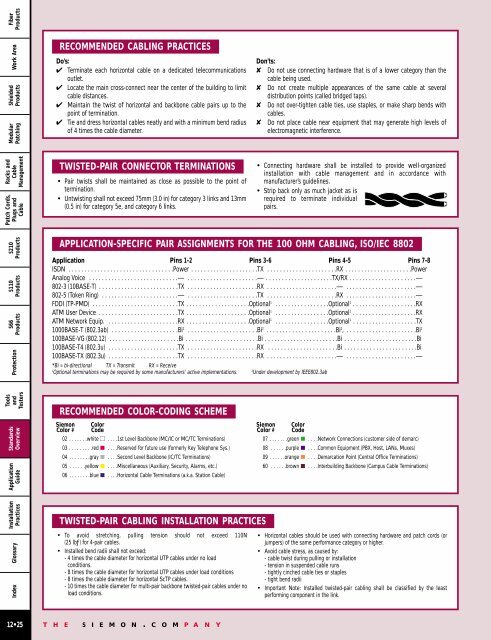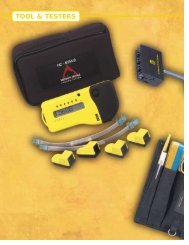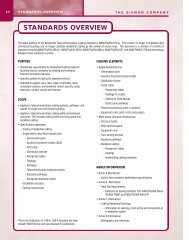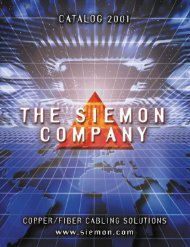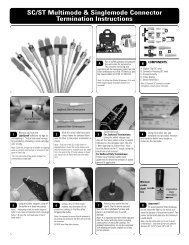fiber products
fiber products
fiber products
Create successful ePaper yourself
Turn your PDF publications into a flip-book with our unique Google optimized e-Paper software.
Fiber<br />
Products<br />
Work Area<br />
Shielded<br />
Products<br />
Modular<br />
Patching<br />
RECOMMENDED CABLING PRACTICES<br />
Do’s:<br />
✔ Terminate each horizontal cable on a dedicated telecommunications<br />
outlet.<br />
✔ Locate the main cross-connect near the center of the building to limit<br />
cable distances.<br />
✔ Maintain the twist of horizontal and backbone cable pairs up to the<br />
point of termination.<br />
✔ Tie and dress horizontal cables neatly and with a minimum bend radius<br />
of 4 times the cable diameter.<br />
Don’ts:<br />
✘ Do not use connecting hardware that is of a lower category than the<br />
cable being used.<br />
✘ Do not create multiple appearances of the same cable at several<br />
distribution points (called bridged taps).<br />
✘ Do not over-tighten cable ties, use staples, or make sharp bends with<br />
cables.<br />
✘ Do not place cable near equipment that may generate high levels of<br />
electromagnetic interference.<br />
Racks and<br />
Cable<br />
Management<br />
Patch Cords,<br />
Plugs and<br />
Cable<br />
TWISTED-PAIR CONNECTOR TERMINATIONS<br />
• Pair twists shall be maintained as close as possible to the point of<br />
termination.<br />
• Untwisting shall not exceed 75mm (3.0 in) for category 3 links and 13mm<br />
(0.5 in) for category 5e, and category 6 links.<br />
• Connecting hardware shall be installed to provide well-organized<br />
installation with cable management and in accordance with<br />
manufacturer’s guidelines.<br />
• Strip back only as much jacket as is<br />
required to terminate individual<br />
pairs.<br />
S210<br />
Products<br />
S110<br />
Products<br />
S66<br />
Products<br />
Protection<br />
APPLICATION-SPECIFIC PAIR ASSIGNMENTS FOR THE 100 OHM CABLING, ISO/IEC 8802<br />
Application Pins 1-2 Pins 3-6 Pins 4-5 Pins 7-8<br />
ISDN . . . . . . . . . . . . . . . . . . . . . . . . . . . . . . . . .Power . . . . . . . . . . . . . . . . . . . . .TX . . . . . . . . . . . . . . . . . . . . . .RX . . . . . . . . . . . . . . . . . . . . .Power<br />
Analog Voice . . . . . . . . . . . . . . . . . . . . . . . . . . . .— . . . . . . . . . . . . . . . . . . . . . .— . . . . . . . . . . . . . . . . . . . . .TX/RX . . . . . . . . . . . . . . . . . . . . .—<br />
802-3 (10BASE-T) . . . . . . . . . . . . . . . . . . . . . . . . .TX . . . . . . . . . . . . . . . . . . . . . .RX . . . . . . . . . . . . . . . . . . . . . .— . . . . . . . . . . . . . . . . . . . . . .—<br />
802-5 (Token Ring) . . . . . . . . . . . . . . . . . . . . . . . .— . . . . . . . . . . . . . . . . . . . . . .TX . . . . . . . . . . . . . . . . . . . . . .RX . . . . . . . . . . . . . . . . . . . . . .—<br />
FDDI (TP-PMD) . . . . . . . . . . . . . . . . . . . . . . . . . . .TX . . . . . . . . . . . . . . . . . . . .Optional 1 . . . . . . . . . . . . . . . . .Optional 1 . . . . . . . . . . . . . . . . . . . .RX<br />
ATM User Device . . . . . . . . . . . . . . . . . . . . . . . . .TX . . . . . . . . . . . . . . . . . . . .Optional 1 . . . . . . . . . . . . . . . . .Optional 1 . . . . . . . . . . . . . . . . . . . .RX<br />
ATM Network Equip. . . . . . . . . . . . . . . . . . . . . . .RX . . . . . . . . . . . . . . . . . . . .Optional 1 . . . . . . . . . . . . . . . . .Optional 1 . . . . . . . . . . . . . . . . . . . .TX<br />
1000BASE-T (802.3ab) . . . . . . . . . . . . . . . . . . . . .Bi 2 . . . . . . . . . . . . . . . . . . . . . .Bi 2 . . . . . . . . . . . . . . . . . . . . . .Bi 2 , . . . . . . . . . . . . . . . . . . . . . .Bi 2<br />
100BASE-VG (802.12) . . . . . . . . . . . . . . . . . . . . . .Bi . . . . . . . . . . . . . . . . . . . . . . .Bi . . . . . . . . . . . . . . . . . . . . . . .Bi . . . . . . . . . . . . . . . . . . . . . . .Bi<br />
100BASE-T4 (802.3u) . . . . . . . . . . . . . . . . . . . . . .TX . . . . . . . . . . . . . . . . . . . . . .RX . . . . . . . . . . . . . . . . . . . . . .Bi . . . . . . . . . . . . . . . . . . . . . . .Bi<br />
100BASE-TX (802.3u) . . . . . . . . . . . . . . . . . . . . . .TX . . . . . . . . . . . . . . . . . . . . . .RX . . . . . . . . . . . . . . . . . . . . . .— . . . . . . . . . . . . . . . . . . . . . .—<br />
*Bi = bi-directional TX = Transmit RX = Receive<br />
1<br />
Optional terminations may be required by some manufacturers’ active implementations. 2<br />
Under development by IEEE802.3ab<br />
Tools<br />
and<br />
Testers<br />
Standards<br />
Overview<br />
Application<br />
Guide<br />
RECOMMENDED COLOR-CODING SCHEME<br />
Siemon Color<br />
Color # Code<br />
02 . . . . . . .white ■ . . . .1st Level Backbone (MC/IC or MC/TC Terminations)<br />
03 . . . . . . . . .red ■ . . . .Reserved for future use (formerly Key Telephone Sys.)<br />
04 . . . . . . . .gray ■ . . . .Second Level Backbone (IC/TC Terminations)<br />
05 . . . . . .yellow ■ . . . .Miscellaneous (Auxiliary, Security, Alarms, etc.)<br />
06 . . . . . . . .blue ■ . . . .Horizontal Cable Terminations (a.k.a. Station Cable)<br />
Siemon Color<br />
Color # Code<br />
07 . . . . . . .green ■ . . . .Network Connections (customer side of demarc)<br />
08 . . . . . .purple ■ . . . .Common Equipment (PBX, Host, LANs, Muxes)<br />
09 . . . . . .orange ■ . . . .Demarcation Point (Central Office Terminations)<br />
60 . . . . . .brown ■ . . . .Interbuilding Backbone (Campus Cable Terminations)<br />
Installation<br />
Practices<br />
Glossary<br />
Index<br />
TWISTED-PAIR CABLING INSTALLATION PRACTICES<br />
• To avoid stretching, pulling tension should not exceed 110N<br />
(25 lbƒ) for 4-pair cables.<br />
• Installed bend radii shall not exceed:<br />
- 4 times the cable diameter for horizontal UTP cables under no load<br />
conditions.<br />
- 8 times the cable diameter for horizontal UTP cables under load conditions<br />
- 8 times the cable diameter for horizontal ScTP cables.<br />
- 10 times the cable diameter for multi-pair backbone twisted-pair cables under no<br />
load conditions.<br />
• Horizontal cables should be used with connecting hardware and patch cords (or<br />
jumpers) of the same performance category or higher.<br />
• Avoid cable stress, as caused by:<br />
- cable twist during pulling or installation<br />
- tension in suspended cable runs<br />
- tightly cinched cable ties or staples<br />
- tight bend radii<br />
• Important Note: Installed twisted-pair cabling shall be classified by the least<br />
performing component in the link.<br />
12•25<br />
T H E S I E M O N . C O M P A N Y


